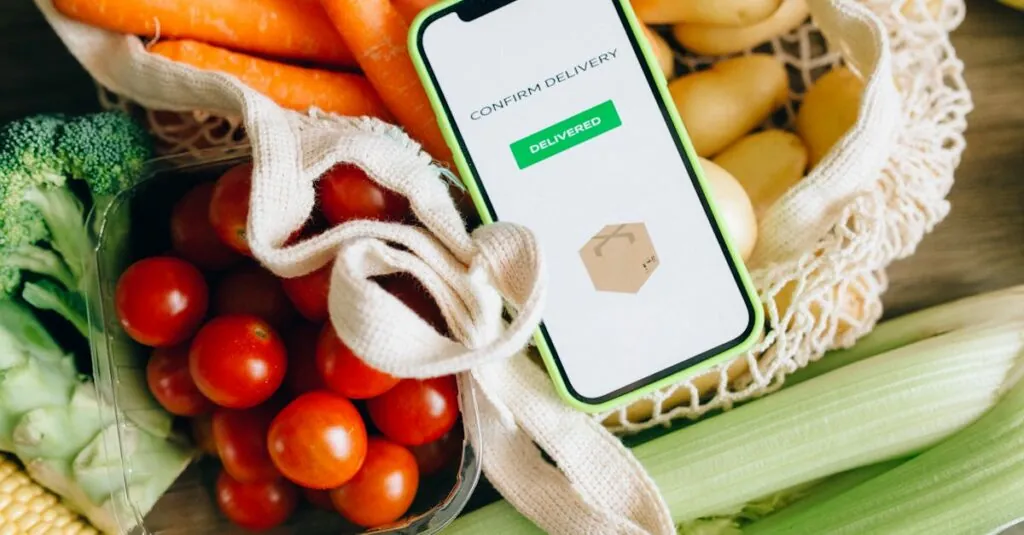Table of Contents
ToggleIn a world where time is money and cooking feels like a distant memory, food delivery apps have swooped in like culinary superheroes. With just a few taps on a smartphone, anyone can summon delicious meals from local restaurants without stepping foot outside. Who needs a cape when you’ve got a pizza in one hand and a burrito in the other?
But it’s not just about convenience; it’s about choice. From gourmet burgers to vegan delights, these apps offer a smorgasbord of options that can satisfy even the pickiest eater. Forget about the days of settling for last-minute takeout. With food delivery apps, the only hard decision is whether to go for dessert first—or second! Dive into the world of food delivery apps and discover how they’re transforming mealtime into a delightful adventure.
Overview of Food Delivery Apps
Food delivery apps offer a seamless way to access a diverse range of meals from local restaurants. Users enjoy convenience, as these platforms eliminate the need to leave home. Generating interest, these apps host a variety of cuisines, catering to numerous dietary preferences.
Ordering through food delivery apps is straightforward. Users browse menus, select items, and complete orders within a few taps. Payment options often include credit cards, mobile wallets, and cash, enhancing flexibility for consumers. Each app has unique features such as real-time tracking and promotional offers that further attract users.
An expanding number of meals includes gourmet, vegan, and international options. Consumers can explore everything from casual takeout to fine dining experiences. Local eateries benefit as these platforms increase visibility to potential customers. Delivery drivers, often working as independent contractors, create new job opportunities within the gig economy.
Research shows that the global food delivery market reached a value of approximately $150 billion in 2021, with a steady growth forecast. Many consumers appreciate the time savings these services provide, leading to increased satisfaction during mealtime. The shift toward convenience reflects changing lifestyles and preferences, especially among younger generations.
Delivery apps continue to innovate. New features, such as subscription models and meal customization, enhance user experience and engagement. They maintain significant competition, continually evolving to meet consumer demands and preferences. Overall, food delivery apps not only transform dining habits but also reshape the restaurant industry landscape.
Popular Food Delivery Apps
Numerous food delivery apps dominate the market, each offering distinct features and advantages. Some of the most popular options include DoorDash, Uber Eats, and Grubhub.
App Comparisons
DoorDash leads in market share, covering over 4,000 cities in the U.S. Its user-friendly interface and extensive restaurant network enhance its appeal. Uber Eats thrives on partnerships, connecting with local favorites and national chains. Grubhub stands out for its strong presence in urban areas, providing unique options for customers. Postmates differentiates itself by offering delivery from convenience stores and retailers alongside food. Each app caters to specific preferences, allowing users to choose based on convenience, availability, and selection.
Unique Features
Many food delivery apps include unique features that elevate user experiences. Real-time tracking allows customers to monitor their orders from preparation to arrival. Subscription services, like DashPass from DoorDash, offer free delivery and reduced service fees to loyal customers. Promo codes and discounts often entice new users, making initial orders more appealing. Some apps feature exclusive partnerships with local eateries, expanding variety. Meal customization options frequently enable users to modify dishes based on dietary needs or preferences. Each of these features enhances convenience and satisfaction, contributing to the overall appeal of food delivery apps.
Benefits of Using Food Delivery Apps
Food delivery apps provide numerous advantages that enhance the overall dining experience. Users enjoy the benefits of convenience and a wide range of options.
Convenience and Time-Saving
Users appreciate the convenience these apps offer. Without needing to cook, individuals save time and reduce preparation hassle. With just a few taps, anyone can order meals from their favorite restaurants, avoiding long waits and crowded spaces. Deliveries often arrive at the doorstep, making dining effortless. Busy schedules find relief when meals come directly to users, allowing more time for work or relaxation. Many apps also feature user-friendly interfaces that streamline the ordering process, making it quick and easy to navigate selections and track deliveries. Accessing delicious food without leaving home caters to modern lifestyles.
Access to Variety
Food delivery apps open doors to astonishing meal choices. They connect users with diverse restaurants and cuisines, making it easy to explore new tastes. Options range from gourmet burgers to authentic sushi, ensuring everyone finds something appealing. Local favorites frequently partner with these platforms, bringing unique flavors to the table. Not only do users enjoy traditional meals but they can also opt for vegan, gluten-free, and other specialized diets, satisfying various preferences. Filters help narrow down selections based on dietary needs, cuisine types, and price ranges, enhancing the overall user experience. This vast variety transforms mealtime into an exciting culinary adventure.
Challenges and Considerations
Food delivery apps present several challenges that users and restaurants must navigate. Understanding these challenges helps in making informed choices.
Delivery Fees and Pricing
Delivery fees often vary among apps and restaurants. Users may encounter service fees, distance charges, or surge pricing during peak hours. For example, delivery fees can range from $1 to $10 based on order size or geographic location. Special promotions might offer reduced fees or free delivery on certain orders. Pricing transparency becomes vital, as unexpected costs can affect user satisfaction. Customers should always check the final price breakdown before completing an order to avoid surprises.
Food Quality and Safety
Food quality remains a crucial consideration for users. The speed at which meals are delivered can impact freshness. Restaurants often package food to retain quality, but transport times can vary. Safety during delivery is another factor; food must be kept at safe temperatures to prevent spoilage. Many delivery apps provide guidelines for drivers to ensure hygiene standards are met. Users might consider reviews and ratings to gauge the food quality from specific restaurants before placing an order.
Future Trends in Food Delivery Apps
AI integration is expected to revolutionize food delivery apps. Predictive analytics can help these platforms anticipate customer preferences and optimize meal recommendations. Real-time order tracking technology is also likely to advance, enhancing user experience through increased transparency.
Sustainability will play a crucial role going forward. More apps might adopt eco-friendly packaging and promote restaurants that follow sustainable practices. This shift aligns with consumer demand for healthier options that benefit both their diets and the environment.
Contactless delivery options are on the rise. Consumers prefer minimal interaction, particularly post-pandemic. As a result, apps will implement features that allow for secure, contactless drop-offs.
Subscription services might gain popularity. Regular customers could access monthly meal plans with discounted rates. This model not only improves customer loyalty but also streamlines restaurant operations with predictable demand.
Enhanced meal customization features are likely to attract diverse audiences. More options will cater to specific dietary needs, enabling customers to tailor their orders. These personalized experiences can reduce food waste and increase customer satisfaction.
Blockchain technology could enhance transparency. This innovation may ensure food safety and authenticity, giving consumers confidence in their meal choices. Improved traceability can strengthen relationships between restaurants and customers.
Lastly, partnerships with grocery delivery services might become commonplace. Cross-industry collaboration will provide users with a one-stop shop for meals and groceries. This integration underscores the evolving landscape in food accessibility and convenience.
Food delivery apps have fundamentally changed how people approach dining. Their convenience and variety make them an attractive option for those seeking quick and diverse meal solutions. As these platforms continue to evolve with innovative features and focus on sustainability, they’ll likely enhance user experiences further.
While challenges like delivery fees and food quality remain, the benefits often outweigh these concerns. The industry is poised for growth and adaptation, ensuring that food delivery apps will remain a staple in modern life. With a focus on customer preferences and technological advancements, the future of food delivery looks promising, catering to an increasingly busy society.







